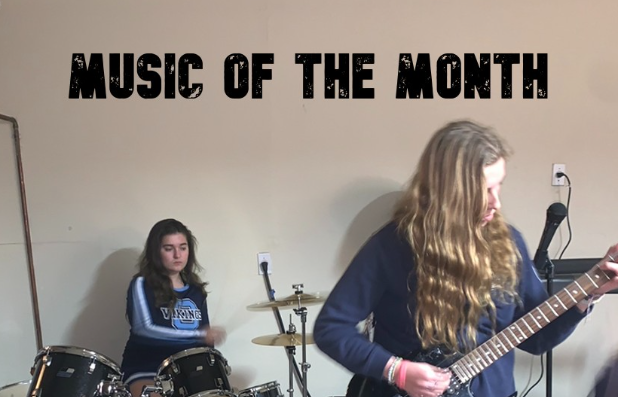Music of the Month: August
A look at our top songs for the month of August.
Cali and Brianna compile a list of their top songs each month and go in depth with them.
August 31, 2022
As summer break comes to a close and school returns to regular fashion, music remains constant in our environment. The hope for this school year is to continue the quality of the articles of “MOTM” and continue listening to music that fills us with joy. For this edition, we’ve also included our favorites from over the summer. As always, enjoy!
Want to see what else we’re listening to? Check out our Spotify accounts!
Cali: Footos | The Fresh Fighter
Brianna: Benusom
Cali’s Picks:
“Floods” by Pantera, “The Great Southern Trendkill”(1996)

This dissonant number on Pantera’s eighth studio album, “The Great Southern Trendkill”, embodies the gut-wrenchingly heavy themes and sounds that are present throughout the record. Unique to many songs in Pantera’s catalog, “Floods” has a ballad-like structure and starts off with an eerie-sounding clean guitar. Phil Anselmo’s echoey and reverberated vocals in each line of the verse are repeated in a hushed and lower manner, to create a nearly spine-chilling effect. Each chorus contains the tortured chords of Dimebag Darrell’s guitar and Anselmo’s muttered, then yelled vocals, that continue the harrowing notions of the track. Following the second chorus, the track takes on a new energy after Anselmo snarls the line, “Take him with the floods”, and the word “flood” is quietly repeated five times before Dimebag begins playing a chugging breakdown riff that entices any listener to headbang. The sounds of thunder and rain can be heard many times throughout the track, and plays before Dimebag’s harmonic squeal-filled guitar solo that many regard to be one of the greatest solos in metal history. Although Dimebag truly shines throughout this song, drummer Vinnie Paul (Dimebag’s brother) plays a prominent role with his pounding drums that carry the broken rhythms, as well as begin the outro that ultimately ends the track with a very muffled guitar accompanied by the somewhat soothing sounds of rain. Even though the tune reflects the growing sense of separation between the group members, it serves as a fan favorite and innovative composition in the growing 90s metal scene due to its diversity, complexity, and subtle hookiness.
“Promise” by Violent Femmes, “Violent Femmes”(1983)

The seventh song on the Milwaukee trio’s self-titled debut album that pioneered the genre of folk punk through its themes of alienation, desire, unrequited love, and other teenage feelings. Short but sweet, “Promise” simply is the epitome of the anxiety and nervousness that come with having feelings for somebody. Like many other Violent Femmes songs, the track is filled with Gordon Gano’s jazzy guitar riffs and jumbled vocals, Brian Ritchie’s slap acoustic bass, and Victor DeLorenzo’s rolling snares. The verses present Gano’s somewhat-sprechgesang singing voice, and flow directly into the upbeat chorus that is riddled with funky basslines and sweetly high-pitched guitar chords. As Violent Femmes often approach their songs with an avant-garde style, the bass-heavy second verse and chorus sink into the deeper side of Gano’s ballad of seeking love as he explains his current struggles in a lower, more dulcet tone of voice. In this next chorus, Gano belligerently holds out the final line for nearly 10 seconds, as the band continues to play on and carries out into the harmonized and sing-songy bridge. After a rallying cry of, “two, three four”, the band goes back to the first verse, repeats the initial chorus, and ends the song on the duplicated line of, “This is only a guess”. Although “Promise” isn’t regarded as a well-known Violent Femmes song, it’s bountiful and screaming with youthful energy that can make even the sternest crack a smile or dance along.
“Transcending” by Red Hot Chili Peppers, “One Hot Minute”(1995)

Following the large commercial success of “Blood Sugar Sex Magik”, and the departure of guitarist John Frusciante mid-tour, Red Hot Chili Peppers desperately searched for a touring guitarist, which they found in Jesse Tobias, to finish up their disastrous 1992 world tour. After returning home, Tobias left the band, and the other members regrouped, and hit the studio in 1994 with new ideas and Jane’s Addiction guitarist Dave Navarro. The end result was, “One Hot Minute”, which highly differentiated from the bands’ previous sounds, causing a high amount of distaste among many fans; but the creation of a cult classic for other followers of the group. Written as a tribute to the late actor, activist, and musician, River Phoenix, who was very close to the band members, especially bassist Flea, “Transcending” brings listeners on an emotional rollercoaster through the dynamism of the ditty. The song begins with a snappy, yet fitting bassline delivered by Flea that is soon accompanied by Navarro’s calming guitar. The song pays heartfelt homage to Phoenix through the extremely mellow and percussive verses, as well as the touching lyrics (“Like no other, I love you, you’re my brother”, “A part of me left that only you knew”, and “Friends near death, you gave respect/Sympathetic intellect”). The verses are bridged together by melodic rhythm sections that include pulsing drums courtesy of Chad Smith, Anthony Kiedis’ emotional vocals, and Navarro’s prominent guitar licks. Following the second melancholy bridge, the track takes a dive into a completely new direction into an outro section riddled with whammy trills, pinch harmonics, and haphazard drumming. The lyricism in the outro shines light on the uglier side of Phoenix’s story; like the negativity the press had on his posthumous reputation and stigma his family faced in the media. As the closing number on “One Hot Minute”, “Transcending” simply leaves the listener in awe with the genuine and tear-jerking verses, and the blatant and hard-hitting outro that ends the album with a bang.
“Ode To The Mets” by The Strokes, “The New Abnormal”(2020)

First premiered live at their Brooklyn New Year’s Eve concert in 2019, “Ode To The Mets” serves as the final track on The Strokes’ long awaited sixth studio album, “The New Abnormal”. The song contrasts to early styles of the band, and replaces upbeat melodies, staccato guitar bursts, and danceability with appeasing guitars, carefully placed cello, and well-thought lyrics. The nostalgia-provoking ballad begins with a short bit of an 80s-like synthesizer progression that fades away and is quickly overtaken by Albert Hammond Jr.’s clean guitar riff. The first verse composes of Julian Casblancas’ soothing vocals, Hammond and Nick Valensi’s poignant guitars, the smooth cello, Nikolai Fraiture’s crisp bass, and is completely absent of drums. That is, until Casablancas murmurs the fan favorite line, “Drums please, Fab”, and drummer Fabrizio Moretti begins playing a rhythmic line that carries out throughout the rest of the song. Despite the title displaying a tune dedicated to the New York Mets, the song isn’t necessarily about baseball. Casablancas pinned the lyrics to the track following the Mets’ loss to the San Francisco Giants in the 2016 NL Wild Card Game, but he states there is a level of ambiguity to the words. However, many would interpret it as a look back at his life and career in New York City. The trancey number is ultimately quieter than many other Strokes songs until the climax of the last verse that possesses louder instrumentation that continues to the outro and anthemic lyrics like, “Gone now are the old times” and, “So pardon the silence that you’re hearing/it’s turning into a deafening, painful, shameful roar”. The track has taken on popularity since its release, turning on old fans as well as new listeners to the versatility of the Strokes and their ability to adapt to today’s music realm.
“Lay Lady Lay” by Ministry, “Filth Pig”(1996)

A distinctive cover of the Bob Dylan classic that greatly separates itself from the original with its growling vocals, shrill guitars, and industrial soundscape. Throughout the making of “Filth Pig” Ministry tended to stray away from their previously heavier sounds in turn for more audio experimentation that oozes with sludge and grime. The trippy number kicks off in an almost psychedelic fashion with a highly distorted bass, multiple forms of percussion, and a rhythmic pedal steel acoustic guitar. The hypnotic declining wails of the electric guitar beautifully coincide with the echoing and muffled croons of vocalist AI Jourgensen throughout the chaotic verses. Following each quieter voice, the enthralling and louder chorus takes precedence through the striking drums, fitting guitar, and harmonious vocals. The choruses are bridged together to the next verse through the transcendental instrumental break that greatly expresses the overall tones of detachment and desire. During the electric bridge, the song hits an overall peak as Jourgensen screams Dylan’s iconic lines, and the overdriven power chords of the guitar fade away as the composition takes a few measures of rest, then comes back and returns to the intro. The track ends in the repetition of the line, “lay lady lay” that Jourgensen bellows as the instruments slide away and fade out. Overall, “Lay Lady Lay” became one of Ministry’s most popular songs, and the media attention it received led the group to eventually earn a Grammy nominee in 1999, and put more of a spotlight on the mysterious and overlooked genre of industrial metal.
Brianna’s Picks:
“A Clean Break (Let’s Work)” by Talking Heads, “The Name of This Band is Talking Heads” (1982)

The second track on Talking Heads’ double live album, “A Clean Break (Let’s Work)” is derived from the fusion genre Funk rock, and new-wave’s combination of the 70s and 80s pop-oriented nature. Much of the track’s groove is heavily reliant on the drums. Chris Frantz’s drumming in this track is both intricate and rhythmic. Unlike many songs, this track focuses on the driving drum beat that is accompanied by the sporadic and slightly buried guitar. But between the sparse guitar and sharp drumming, lead singer David Byrne delivers choppy sentences (which creates emphasis and clarity in the vocals), sustained falsettos, and vocalize throughout moments of the track that become more and more abstract. With this in mind, the staccato verses highly contrast the melodic choruses. With their upbeat and rhythmic energy, Talking Heads brought Avant-funk with the second track on their new-wave live LP.
“Go It Alone” by Beck, “Guero” (2005)

Beck’s bluesy track on his ninth studio album, “Go It Alone” exhibits dejection through the imagery of each verse. This track features Jack White of The White Stripes playing a very prominent bass line throughout the song. White also co-wrote “Go It Alone” with Beck within five minutes. White’s driving bass protrudes over the vocals but doesn’t dominate Beck’s soft-spoken verses and gentle chorus refrains. In his earlier works, Beck was often creating comical, eccentric, and experimental tracks. As more albums were released, Beck continued his jocular vocals, but drifted towards themes of introspection and solitude. Nevertheless, Beck continues crossing genres; especially in this bluesy track compared to his other works of funk, hip-hop, and alternative. The chorus of “Go It Alone” features Beck harmonizing with himself which in turn adds more to the captivating vocals. The refrain also spotlights Beck sampling his own song “E-Pro”, which is the first track off the album.
“Sikamikanico” by Red Hot Chili Peppers, “Wayne’s World: Music from the Motion Picture” (1992)

Recorded during the “Blood Sugar Sex Magik” sessions but not included on the album, “Sikamikanico” is fast-paced, lively, loose, and full of energy — much like all other tracks included on their fifth studio album. Anthony Kiedis’ vocals and John Frusciante’s crisp and brittle guitar tone alternate during the verses but join together for the choruses. “Sikamikanico” still includes attributes from “BSSM” and the RHCP sound as a whole such as the pummeling bass courtesy of Flea. The iconic drive of the bass is the most prominent in between verses and is extremely fast-paced during the chorus, much like the other features of the track during that section. Much like in the second to last track “Sir Psycho Sexy” on “Blood Sugar Sex Magik”, Flea and Frusciante join Kiedis for the expeditious chorus. Opening the track, Frusciante begins with his isolated guitar track that is highly rhythmic accompanied by Chad Smith’s hi-hat. Entering the track with his rap-style lyricism (which was a staple for the band in their earlier works), Keidis uses assorted vocal tones throughout different moments on the track as seen in lyrics such as “You might receive my radio waves” and “Hey Joe, a radio chump”. Included on the track is also Smith’s punchy drum beat especially evident in the chorus. Even though the majority of the song has a very high tempo, the bridge after the second chorus is more melodic and leisurely. Beginning the bridge is likely a reference to The Ramones’ debut single and biggest hit “Blitzkrieg Bop” with the iconic line respectively in both “Sikamikanico” and “Blitzkrieg Bop”; “Hey! Ho! Let’s go!”. This amazing breakdown highly contrasts the rest of the song by Kiedis’ overlapped and delayed vocals which evoke a flowing feeling compared to the disconnected. Although the track was omitted from the album, it still made appearances on the “Wayne’s World” soundtrack, RHCP’s compilation album “The Plasma Shaft”, and as a b-side for the release of the “Under the Bridge” single. “Sikamikanico” is an exceptional track that should have been included on “BSSM” however it is still fitting to be a strong title on “Wayne’s World: Music from the Motion Picture”.
“I Know Somethin (Bout You)” by Alice In Chains, “Facelift” (1990)

With the recent anniversary of Alice in Chains’ debut album “Facelift”, lead singer Layne Staley’s heavenly birthday the following day, and the highly anticipated 30th anniversary of the critically acclaimed LP “Dirt”, it was only fitting to include an AIC track on this month’s edition. “I Know Somethin’ (Bout You)” sets apart from other AIC tracks because of the instrumentation and the groove which it evokes. The track begins with Jerry Cantrell’s rhythmic guitar accompanied by Sean Kinney on the hi-hat. Cantrell’s standard guitar tone in other works is dark and grainy while this track has a much brighter and clean tone. With each part of the song, Kinney provides a varying drum beat for each distinctive section. The standout 11th track also highlights Mike Starr’s exceptional bass performance with it being the driving foundation of the entire song. Starr joins the other instruments midway through the intro which emphasizes the prominence of the bass even more once he enters. Written by Cantrell, “I Know Somethin (Bout You)” is very distinctive from other tracks in their discography, but there are still many essential elements of AIC that are included such as Cantrell and Staley’s vocals. The entire band is in tune with each other in general, but this track especially spotlights the overlapping and harmonizing by Cantrell and Staley in the chorus. Staley’s overlapped sustained notes on top of Cantrell’s dulcet vocals create one of the catchiest choruses in the AIC catalog. Although the track is upbeat and full of energy, “I Know Somethin (Bout You)” is presumably about Staley’s drug addiction during that time and how it reflected him as a person, though a song’s true meaning is never known for certain unless directly stated by the writer. With the success of their debut album, Alice In Chains composed songs that didn’t put the sound of a band in a box, even on their debut album. Including this funk metal track on the gloomy and ominous record could have been that the band didn’t want to limit themselves with their composing. Regardless, AIC’s versatile track contrasts all other songs on “Facelift” and remains a preeminent song in their discography.
“Good Enough” by Tom Petty and the Heartbreakers, “Mojo” (2010)

On the second-to-last studio album of Tom Petty and the Heartbreakers, the 15th track “Good Enough” is a hidden gem within the TP & TH discography. The song erupts into a mellow and loose instrumental intro with Mike Cambell’s guitar being at the forefront of the track. Behind the clean and sharp-toned guitar is the loose drumming of Steve Ferrone, who replaced Stan Lynch in 1994 due to his personal and musical differences with Petty. Underneath it all, but still distinguishable, is the melancholic bassline of Ron Blair, which is continued throughout the entire track. After the phenomenal intro, Petty enters the track with his iconic vocal tone. His lyrical style consists of straightforward lyrics, but is filled with imagery that paints an entire picture with the use of very few words. Petty’s well-known drawl is evident in the majority of his works but adds another layer to this track. Nothing in this song feels restrained. Even Petty’s transition from the low drawl in the verses to his wailing chorus is notably more hard-hitting with the full chorus. The song concludes with a very lengthy instrumental outro that emphasizes the guitar even more.




